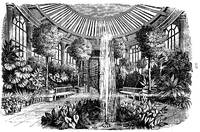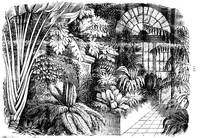375. In Austria and Hungary the principal botanic gardens are those of Schonbrunn and Pesth. There are also near Vienna those of Rennwegg (a private garden of the emperor), Laxenburg, Hetzendorf, the Burg-garten, and the Belvedere; the last containing a complete collection of Austrian plants. There is also the garden of the university, which is considered next in rank to the imperial botanic gardens, and which has been lately greatly enlarged and enriched by the addition of many new plants. The Schonbrunn botanic garden was begun with the palace, in 1753, by the Emperor Francis I. He desired that that establishment should be worthy of the imperial magnificence, and that it should extend the domain of botany, in bringing together vegetables then unknown in Europe. By the advice of Van Swieten, he procured two celebrated florists, the one from Leyden and the other from Delft. The first, Adrian Steckhoven, directed the construction of the hothouses; and the second, Van der Schott, brought all the plants which he could collect in the gardens and nurseries of Holland. Thus the first year they were in possession of many curious species; but this was only a step towards the end they had in view. The Emperor proposed to the celebrated Jacquin to go to the Antilles. This botanist departed in 1754, accompanied by Van der Schott, and two Italian zoologists, employed to procure animals for the menagerie and the museum. These travellers visited Martinique, Grenada, St. Vincent, St. Eustatia, St. Christopher, Jamaica, Cuba, Curacao, and other places. In 1755, they sent home their first packages, and in 1756 Van der Schott arrived with a collection of trees and shrubs, almost all in good condition. The trees were five or six feet high, and many had already borne fruit: their were taken up with balls, and the earth enveloped with leaves of bananas, tied by shreds of underbark. Thus packed, the average weight of each was about 100 lbs. These plants, and the water accessary for them, formed the greater part of the cargo of a vessel which had been forwarded from Martinique to Leghorn. From Leghorn the plants were transported on the backs of mules, and placed in the plain ground in the hothouses built to receive them. The third and the fourth quantities came in the same manner. The fifth and sixth arrived from Caraccas, by Amsterdam. At last Jacquin left Havannah, and conducted to Schonbrunn the last collection in 1759. During this time presents and purchases were received from other countries; and, in proportion as the plants increased, they built hothouses and orangeries of a grandeur suitable to the plants destined to grow in them. One range is 270 feet long, and 30 feet high within; another above 300 feet long, and about the same height; and there are three more ranges, each about 240 feet long. An accident, in 1780, caused the loss of most of the plants of the great hothouse. Van der Schott being sick, the gardener who supplied his place forgot, during a very cold night, to light the stoves. Perceiving it in the morning, he thought to remedy the evil by making a very brisk fire. This sudden change of temperature caused many of the trees to perish, the trunks of some of which were of the thickness of the arm. To repair this loss, Joseph II. engaged the naturalists to undertake a new voyage. Professor Mï¾µster was named chief of the expedition, with Dr. Stupiez for a companion; the gardeners Bose and Bredemeyer, and the drafts-man Moll. They went direct to Philadelphia, visited the United States, Florida, and New Providence, sent home a large collection, and Bose afterwards got charge of the garden of Schonbrunn. (Townson's Travels, &c.) Of late years this collection has been greatly increased by the present director, Brede- meyer, who has brought together all the principal species and varieties of the genus Citrus, and many Cape and Australian plants not before in the garden. The hothouses of Schonbrunn, Townson observes, about the end of the last century, 'are the most spacious that have yet been constructed in Europe; the trees of the tropics there develope their branches in full liberty, and bear flowers and fruits. The most rare palms, the Cocos nucifera, the Caryota urens, the Elï¾µ'is guineensis, grow there with vigour. The Corypha umbraculifera extends its large leaves for twelve feet round, and birds of Africa and America there fly from branch to branch among the trees of their country. ' Jacquin published successively three great works, Illustrating the plants of these gardens, viz. Icones Plantarum rariorum, Hortus Sch£nbrunensis, and Fragmenta Botanica. This garden also contained one of the finest orangeries in Germany. The botanic garden at Rennwegg was chiefly remarkable for its palm-house (fig. 116.); in which not only palms, but scitamineous plants, grew with a luxuriance rarely to be met with on the Continent. These plants, however, are now sent to Schonbrunn, and the house which contained them has been converted into a saloon where the Horticultural Society of Vienna now holds its flower shows, that part of the garden having been given to the Society by the Emperor. The winter-garden of Prince Lichtenstein (fig. 117.) is devoted to plants of show rather than of botanical interest, and is justly considered one of the most luxurious covered promenades in Germany. The burg-garten (castle garden) is a large collection of rare New Holland plants, in a range of mag-nificent hothouses, finished in the year 1818. Attached to these hothouses is a large room, which, in winter, is filled with forced flowers; and, by means of a covered walk, this range is connected with another, which contains one of the best collections of succulent plants in Germany. (Gard. Mag. vol. iv. p. 272.) The botanic garden belonging to the University of Vienna has been greatly improved under the director-ship of Dr. Endlicher, and a new museum and lecture-room were added to it. The museum contains an excellent collection of books on botany, as well as dried plants, &c. The botanic garden of Pesth was established in 1812, and enlarged in 1815: it was placed under the direction of Professor Kitaibel, known in the scientific world as one of the authors of Plant£ rariores Hungari£; Waldstein being the other.



